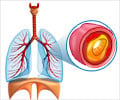Discover how sugar modifications, particularly sialic acid, impact mucus formation and transport, contributing to diseases like cystic fibrosis and COPD.

Reduced sialylation of airway mucin impairs mucus transport by altering the biophysical properties of mucin
Go to source).
‘#Mucus is composed primarily of water and #sugar-coated proteins called #mucins, which help trap harmful particles like #bacteria and #viruses in #airways. #medindia’





Role of Mucus in Airway Defense and Muco-Obstructive Diseases
Numerous dangerous microorganisms might enter a person’s lungs with every breath. One of the first lines of defense and helpful in getting rid of harmful germs is mucus, the slimy, gel-like substance that coats the airways.The mucus is transported up and out of the airways by the beating of microscopic hair-like projections called cilia. It entraps bacteria, viruses, dust, and pollen to protect the lungs.
What happens when the body generates too much mucus, which is too thick, sticky, and dehydrated to move and clear properly?
When mucus becomes too thick and sticky, it can eventually clog the airway, overpowering the systems that clear mucus, and create an ideal environment for bacteria that are trapped.
Muco-obstructive disorders, such as cystic fibrosis, or CF, are a result of these pathophysiological mechanisms.
Advertisement
Sialic Acid and Its Influence on Mucus Transport
Mucus is a hydrogel composed primarily of water and solid matter, including large sugar-coated protein molecules, called mucins, the principal component of mucus.The research focused on the addition and removal of a terminal negatively charged sugar modification, called sialic acid, of MUC5B, one of the major mucin proteins found in the airway.
Advertisement
When the researchers reduced sialic acid on MUC5B, they observed a change in the electrophoretic mobility for the protein indicative of a lower charged form.
Transmission electron microscope imaging showed reducing sialylation contributed to entangled (more compact) MUC5B polymers when compared to normal levels of mucin sialylation that facilitate linearization and expansion.
The reduction in negative charge, by blocking α-2,3 sialylation specifically, influenced the mucus structure and affected its transport in human bronchial epithelial cells and on rat trachea models of an intact airway.
Thus, the authors report that “the mucin charge may bear pathological significance in muco-obstructive diseases through increased mucus compaction and transport impairment.”
The study also found that patients with CF have a reduced expression of an enzyme called ST3Gal1, which adds α-2,3 sialic acid to mucin proteins.
However, treatment with cystic fibrosis transmembrane conductance regulator protein correctors Elexacaftor, Tezacaftor, and Ivacaftor partially recovered the expression of ST3Gal1.
By showing a crucial role for mucin sialylation on mucus properties and transport, the study identified a possible therapeutic strategy for the treatment of cystic fibrosis and potentially other debilitating muco-obstructive diseases, such as chronic obstructive pulmonary disease, or COPD, primary ciliary dyskinesia and non-cystic fibrosis bronchiectasis.
Reference:
- Reduced sialylation of airway mucin impairs mucus transport by altering the biophysical properties of mucin- (https://www.nature.com/articles/s41598-024-66510-2)
Source-Eurekalert









